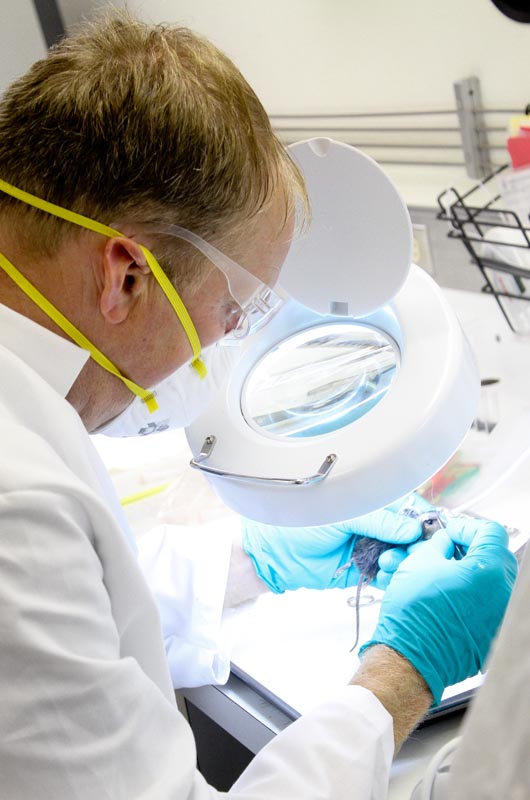Tick season reaches its peak in the month of August, and a group of researchers from the University of Massachusetts at Amherst and the Environmental Protection Agency took advantage of the warm weather to work on their latest effort in the quest to understand tick-borne diseases.
Dr. Stephen Rich, professor of microbiology at the University of Massachusetts and director of the Laboratory of Medical Zoology, and a rotating group of undergraduates, graduate students and research fellows, spent two weeks on the Vineyard working with EPA biologist Bart Hoskins. The study was an extension of previous work conducted on the Cape and Islands by Dave Simpson from Barnstable County, who studied tick population management. Mr. Simpson had been testing ticks for Lyme disease. Dr. Rich and Mr. Hoskins’s work extends the testing to anaplasma and babesia pathogens, looking specifically at the small mammals that are carriers of the diseases.
When a tick is newly hatched it does not carry any pathogens; it can become a carrier only after its first blood meal, which a larva needs to molt into the nymphal stage. Tick larvae feed on small mammals such as the white-footed mouse, and the bacteria in the mouse’s blood get transferred to the tick upon feeding.
“When they molt to the next stage to be nymphs, they infect other mice and it sort of amplifies,” Mr. Rich said.
Much lab work has been done on the transmission of Lyme disease via the white-footed mouse, but anaplasma and babesia are not as well studied, prompting the interest in the current research. When Dr. Rich’s lab first began testing Mr. Simpson’s ticks for Lyme in 2007, he checked in to the other two pathogens and found that incidence rates were highly variable. Lyme, by contrast, has a relatively uniform incidence rate.
“You find about 30 per cent of the nymphal ticks, the ones that are active in early summer, are infected with Lyme, no matter where you go,” Mr. Rich said. Anaplasma infection rates, on the other hand, varied from site to site and year to year. The first goal of the study was to determine whether or not the mammal carriers for anaplasma and babesia were different than those for Lyme.
During the group’s two weeks on the Vineyard, they set traps on Chappaquiddick, at Cedar Tree Neck and at Sepiessa Point, working in collaboration with The Trustees of Reservations and the Martha’s Vineyard Land Bank, and using historical sites already mapped by Mr. Simpson in his research. Nantucket and the Cape have an additional 11 sites that are used in the study. White-footed mice have been the most common capture so far, but squirrels, shrews and voles were also found.
“We have these 14 sites for which we have historical data, so we know what the nymphal infection rates are,” Mr. Rich said. “We know where the bugs are, as it were, and because we have that historical data we want to figure out ecologically what’s driving this.”
This summer’s study focuses on the larval ticks, because, as Mr. Hoskins explained, “if you pick up a nymph from a small mammal, you have no idea where it picked up whatever pathogen it’s carrying.” But if a larval tick is carrying pathogens, the only place it could have picked them up was its current small mammal host. Analyzing the larval ticks and the diseases they carry gives a good snapshot into the primary hosts. Though Mr. Rich has been analyzing ticks from the 14 sites since 2007 — missing a year due to lack of funding — this is the first time any effort has been launched into the larvae.
“The first wave of data gave us some indication — it would be fair to say that white-footed mice are still of interest,” Mr. Rich said.
On the Vineyard, the small mammal density is much higher than on the Cape. The best night of trapping, on Chappaquiddick, saw a 40 per cent success rate. By contrast, Mr. Hoskins said, “On the Cape you might see four per cent.” The same amount of traps are set out in each site to provide a means for comparison across the sites. Using a mobile laboratory provided by the EPA, the researchers then work to pluck ticks off the animals — anywhere from three to 30 per mammal, with more than 400 mammals collected in total at the 14 sites. The ticks will then be studied in the University of Massachusetts laboratory.
“There is no systemic surveillance [of anaplasma] being done by the state, so the other part of this is we’re bringing tools to bear . . . that don’t get deployed very often,” Mr. Rich said. “It could be that we’re just looking the right way for the first time, but it could be that there’s something different at all these different sites.” Each of the sites is different ecologically, and it could be that the incidence rates are variable because of the different environments.
“That’s the unique thing about these — they’re environmental problems even though they’re infectious problems,” Mr. Rich said. “It’s a medical problem [but] it’s acquired in the environment.”
“We won’t know how to manage it if we don’t understand the ecology of these diseases,” Mr. Hoskins said.









Comments (1)
Comments
Comment policy »